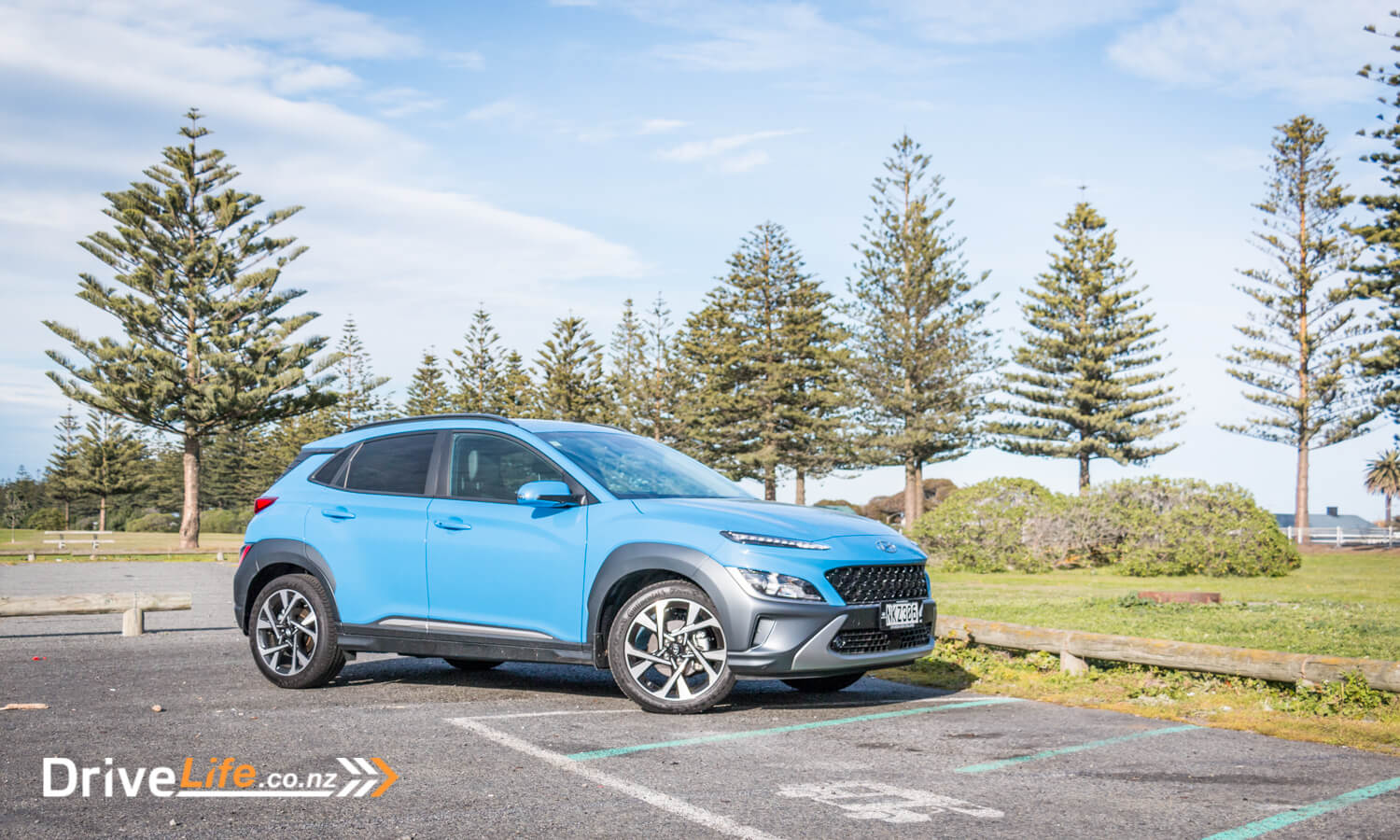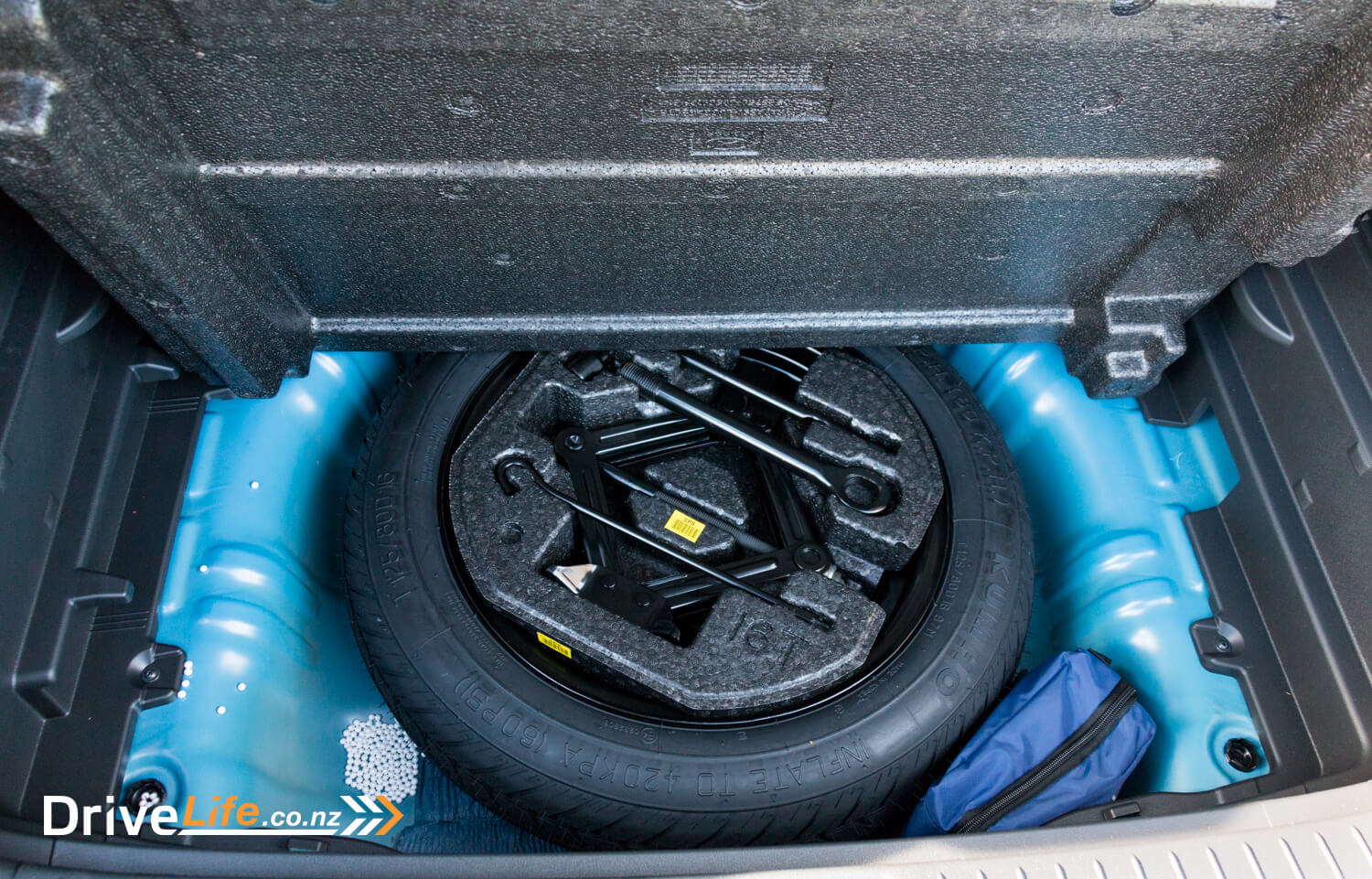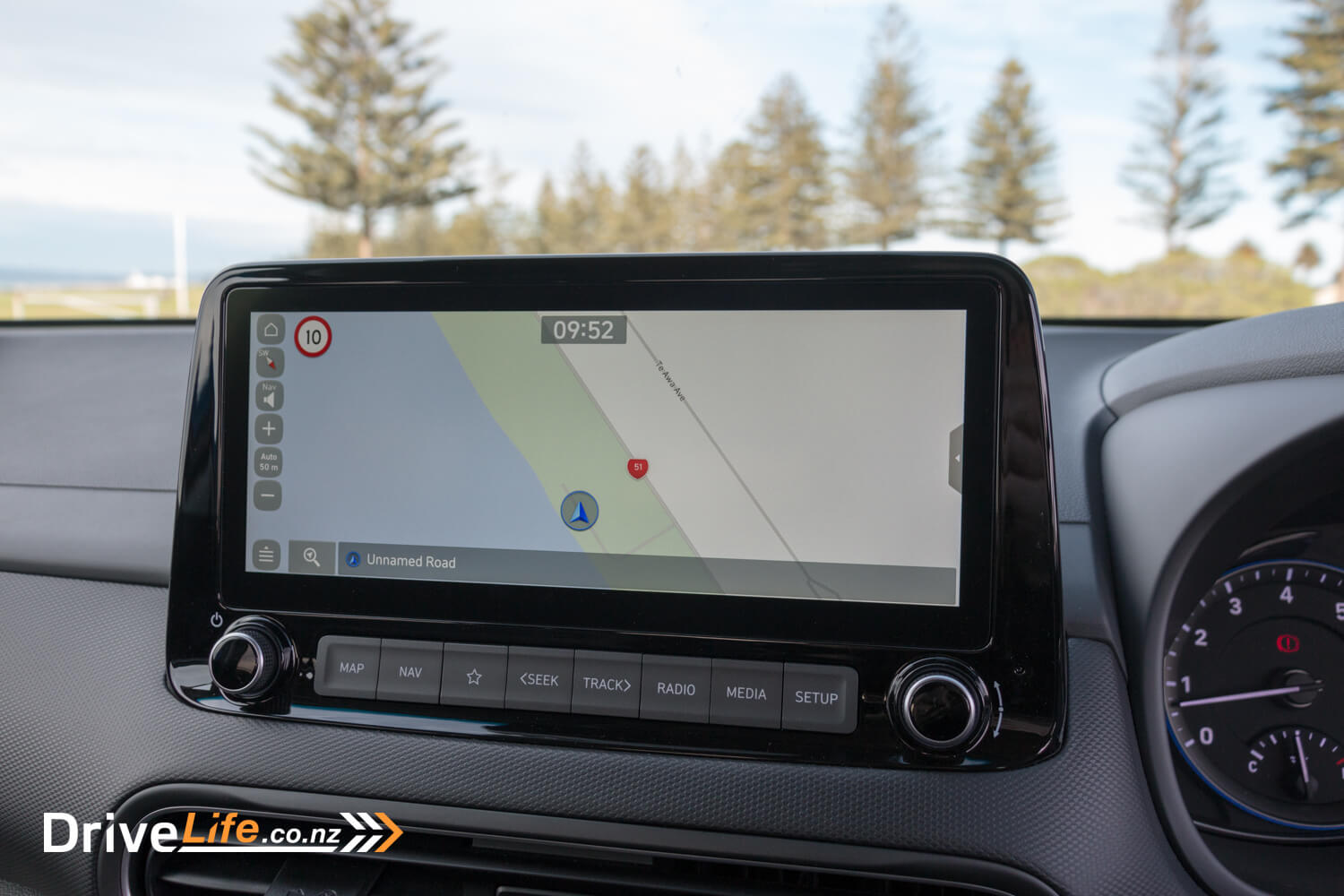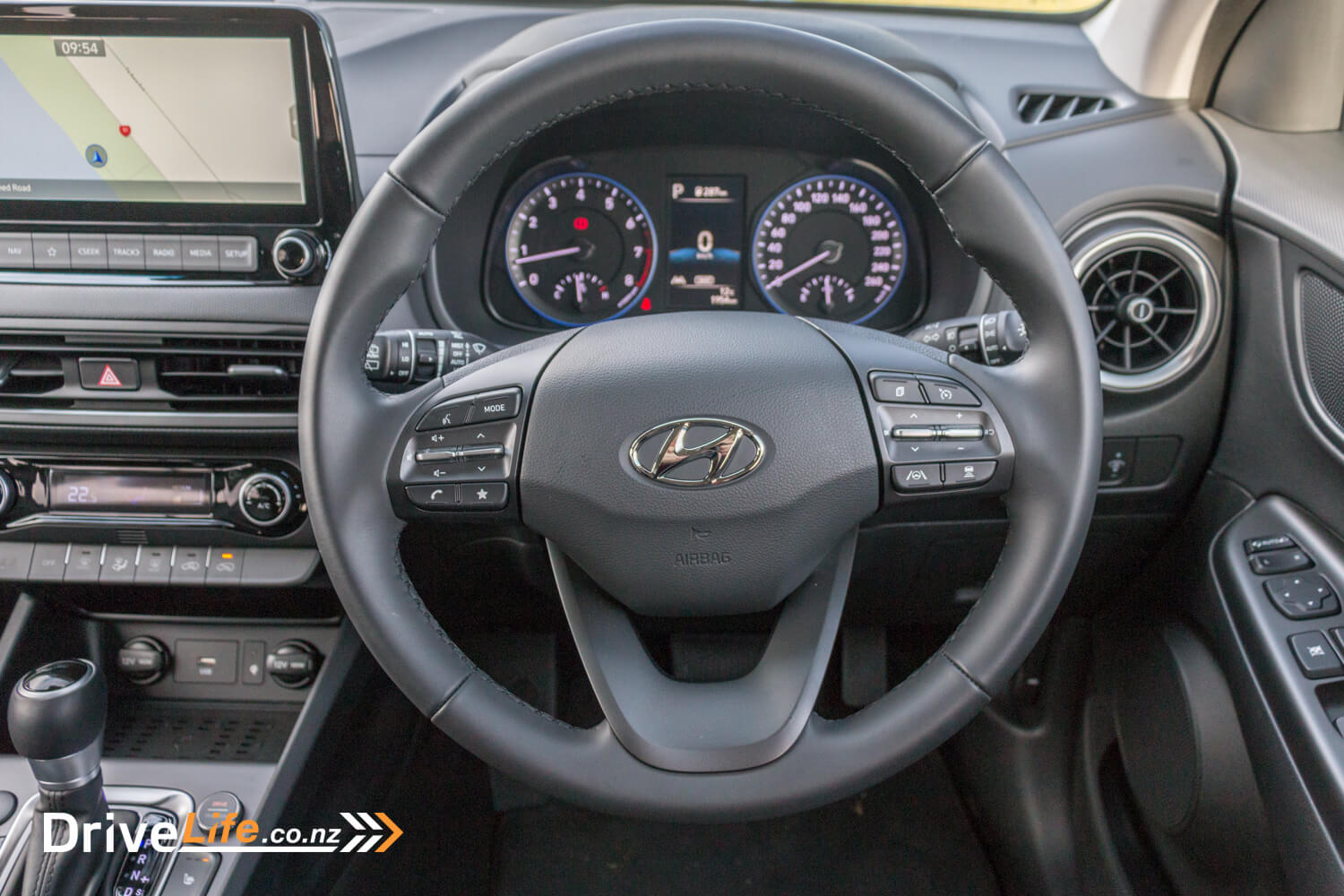
I remember driving the all-new Kona back in 2018, and liking it very much. Now it’s back with the Kona Series II. Has the Kona aged well compared to the huge numbers of SUVs now in the market? Have they fixed the things I complained about? Well it’s yes to the latter, the Kona now has smart cruise control and SatNav included, along with a big list of other safety and quality improvements.
After a week in the new Kona, including a road trip to Napier, would I still think of it as fondly?

What’s In The 2021 Hyundai Kona Range?
The Kona Series II comes in four trim levels, starting with the $34,990 entry-level which features a 2.0-litre 4-cylinder engine making 110kW of power and 180Nm of torque. This drives the front wheels via an Intelligent Variable Transmission. 17” alloys are fitted, with tyre pressure monitoring, ABD, EBD and brake assist. Adding to the acronym list you get ESC, Traction control, Vehicle Stability Management, Blind-spot Collision Avoidance, Rear Cross-Traffic Avoidance Assist, Forward Collision Avoidance Assist (car, pedestrian and cyclist aware), Lane Keep Assist, Smart Cruise, 6 airbags, auto lights, rear parking sensors, reversing camera, heated electric mirrors, cloth trim, 8” touch screen audio, Apple Carplay and Android Auto, 6-speaker stereo, and manual aircon. That’s an impressive list for the lowest spec.
Next up is the Elite, as tested here, at $39,990. On top of the above list you get 18” alloys, auto-dimming rear-view mirror, auto wipers, solar privacy glass, full leather trim, 8-way electrically adjustable driver seat and 6-way electrically adjustable passenger seat, heated front seats, keyless entry and start, 10.25” touch screen, satnav, Harman Kardon 8-speaker audio with subwoofer, climate control, auto windscreen defog.
What else might you need? Well the $44,990 Limited spec is here to give you High-Beam Assist, front parking sensors, Bi-LED headlights, LED tail lights, black roof and mirrors, ventilated front seats, Heads-up display, and a 10.25” full-colour driver display.
Finally there’s the N-Line at $49,990. This is basically Elite spec but with all-wheel drive and a 1.6-litre 4-cylinder GDI turbocharged engine making 146kW of power and 265Nm of torque. Transmission is a 7-speed dual-clutch. On top of the Elite spec you get 18” N-Line alloys, N-Line interior and exterior trim.
Colours available are Atlas White, Dark Knight (grey), Dive in Jeju (greeny-blue), Surfy Blue (as seen on our review car), Misty Jungle (dark green), Galactic Grey, Ignite Flame (red), Pulse Red, phantom Black, Cyber Grey.
You can read more about the Kona on Hyundai’s website here.

First Impressions of the 2021 Hyundai Kona Elite
Hyundai have stuck with the same basic design on the facelifted Kona. They’ve smoothed a line here and there, moved the front badge up, finessed the bumpers and some other details. And it looks good, a small evolution from the earlier model but it was a handsome car to start with. Our review car came in bright Surfy Blue and I think it suits it well.

What’s The 2021 Hyundai Kona Elite Interior Like?
It’s a similar story inside – the same basic dash as the previous model with some tweaks. The central screen has grown and the resolution has improved. Buttons have been moved from the sides to the bottom. The steering wheel has gained a couple of buttons for cruise distance as they’ve upgraded from normal to smart cruise control. And the manual handbrake is now electric.
The interior is generally a little bit on the grey side. There are some hard plastics here and there but in general the touch points are padded or nice to touch. The steering wheel is leather clad, and nicely shaped. There are buttons on the wheel for cruise control and audio and they’re all easy to use without glancing down.
There’s the familiar layout of two large analogue dials for revs and speedo, with a central LCD screen for settings and various information. I kept it set to digital speedo most of the time.They’ve given the number graphics a very 80s style silvered reflection look, which I thought looked a little cheesy.
The Harman Kardon audio system is very good for sound quality. It connects seamlessly to Bluetooth and supports Apple CarPlay and Android Auto. The Qi wireless charger was much appreciated on our weekend road trip. If you don’t have wireless charging there are two USB power sockets in the front, plus a power socket, and a USB port for rear-seat passengers. The screen is responsive with no noticeable lag. It’s a good quality screen with clear and good resolution feed from the rear camera.
There are lots of useful menus and features and settings you can set, but the one I really didn’t understand was the Sounds of Nature menu. The car can be set to play various continuous sounds – forest, busy cafe, roaring fireplace, et cetera. It all seems a bit gimmicky and Tesla-esque. Features with no real point.
The seats are comfortable, electrically adjustable in the Elite and above, and after a longish drive from Wellington to Napier we had no issues at all. As it’s winter in Wellington we definitely appreciated the heated seats, they have 3 stages of heating and stage 1 was plenty for my liking. The aircon works well and the auto-defrost function did a good job of clearing the morning foggy windscreen.
Rear comfort is also good, and there’s leg room for adults in the back. The boot is a decent 374 litres and it easily took our weekend bags, plus some purchases we made along the way.
How Does The 2021 Hyundai Kona Elite Drive?
As you walk up the to Kona with the key in your pocket it opens up the mirrors to welcome you. Unlock the car with the button in the handle, and get inside and you are greeted with a happy little welcome tune and animation on the screen. Basic gimmicks I know, but these little things give a car some extra character.
The Kona proved to be a very acceptable road trip vehicle, it’s comfortable on the open road with a good ride quality. Bumps and imperfections in the road are well damped, as is road noise, with even the rougher chip seal sections staying unintrusive.
Handling-wise, whilst the Kona is no driving enthusiast’s car, it handles neutrally and holds the road well. Most of our Napier trip was spent with cruise control on and set to 100, and I rarely had to slow it down for corners, it just ate up the bends and felt composed doing so.
Performance from the 2.0-litre engine is fine. Plenty for normal driving and the odd overtake. Towards the top end of the rev range it’s all noise and very little go, partly a symptom of the IVT continuously variable transmission flaring, partly I think because it runs out of puff. This encourages you to drive less enthusiastically, because when you do you’re rewarded with near-silence from the engine, smooth running, and a very well-behaved transmission. In fact until the first time I took it out on the highway and went up a big hill, I hadn’t actually realised it was a CVT at all, and that’s impressive because I usually get irritated with them pretty quickly.
As I mentioned above, the Kona now has smart cruise control, and Hyundai’s system is very good, maintaining distances well and braking smoothly. The Lane Assist is less unintrusive, it detects the lines on the road and actively assists with steering, which is fine and works well when there are good clear road markings, but the inconsistency of the lines on New Zealand roads means it only works intermittently. The fact that it does it sometimes and not others causes you to fight it when it does happen, and it gets tiring. The opposite of what it’s meant to achieve.
As well as that, the lane departure warning beeps are pretty annoying. Our route to Napier had lots of road works, and I lost count of the number of beeps and times it tried to steer towards cones because I was crossing lines for contraflows and lane merges. Eventually I realised that you can hold the button on the steering wheel for a full second to disable the system. It reactivates next time you start the car but at least it can be turned off when you want.
While we’re on annoyances, Hyundai have a feature in the SatNav which will beep and warn you about speed cameras, which is great sometimes, especially as it will say “Speed camera 400m ahead, 100kph speed limit”. But other times it just makes the beep with no further info, and nothing displayed, so you wonder what it’s warning about. Or it will alert for a speed camera location which was removed years ago.
My final irritation is something I’ve experienced in several 2021 cars now and that’s over-sensitive active braking at parking speeds. I get that it’s a fantastic safety feature, and could save you hitting a post, or more importantly a pedestrian, but when it brakes for oncoming traffic on the opposite side of the road as you reverse out of a diagonal park, or for an obstacle that just isn’t there, it’s not only annoying but makes you nervous about maneuvering the car in case it does it. Because when it does it stands hard on the brakes and can feel as though you’ve actually hit something. It’s not pleasant.
Other features I really liked, such as the warning of oncoming traffic from behind as you open the door. Just a beep and a sign on the screen, not enough to make you jump. Also there’s the reminder to check the back seats as you get out, and the driver-attention alert picked up that I was getting a bit tired after 3hrs driving, shortly after I had started thinking about stopping for a break and a coffee.
We spent a few days using the Kona around town followed by the long trip and achieved 6.9l/100km, not far off the quoted figure of 6.2. For a 2-litre engine I think that’s an impressive number.

How Does The 2021 Hyundai Kona Elite Compare To The Competition?
| Brand / Model | Engine | Power kW/Nm | Number of Seats | Fuel L/100km | Boot Capacity Litres | Price Highest to Lowest |
| Peugeot 3008 Allure | 1.6-litre 4-cylinder turbo | 121/240 | 5 | 7.0 | 520 | $43,990 |
| Ford Escape Ecoboost | 2.0-litre 4-cylinder turbo | 183/387 | 5 | 8.6 | 412 | $42,990 |
| Mazda CX-30 GSX | 2.0-litre 4-cylinder | 114/200 | 5 | 6.5 | 430 | $42,290 |
| Nissan Qashqai ST-L | 2.0-litre 4-cylinder | 106/200 | 5 | 6.9 | 430 | $41,990 |
| Toyota RAV4 GXL | 2.0-litre 4-cylinder | 127/203 | 5 | 6.0 | 580 | $41,290 |
| Skoda Karoq TSI Ambition+ | 1.4-litre 4-cylinder turbo | 110/250 | 5 | 6.6 | 479 | $40,990 |
| Hyundai Kona Elite | 2.0-litre 4-cylinder | 110/180 | 5 | 6.2 | 374 | $39,990 |
| Honda HR-V RS | 1.8-litre 4-cylinder | 105/172 | 5 | 6.7 | 448 | $39,500 |
| MG HS Essence | 1.5-litre 4-cylinder turbo | 119/250 | 5 | 7.3 | 451 | $39,490 |
| Mitsubishi ASX XLS | 2.0-litre 4-cylinder | 112/200 | 5 | 7.6 | 442 | $39,090 |
| VW T-Cross TSI Style | 1.0-litre 3-cylinder turbo | 85/200 | 5 | 5.4 | 455 | $38,990 |
| Kia Sportage LX Plus | 2.0-litre 4-cylinder | 114/192 | 5 | 6.4 | 491 | $37,990 |
| Suzuki Vitara Turbo Safari | 1.4-litre 4-cylinder turbo | 103/220 | 5 | 5.9 | 375 | $34,690 |
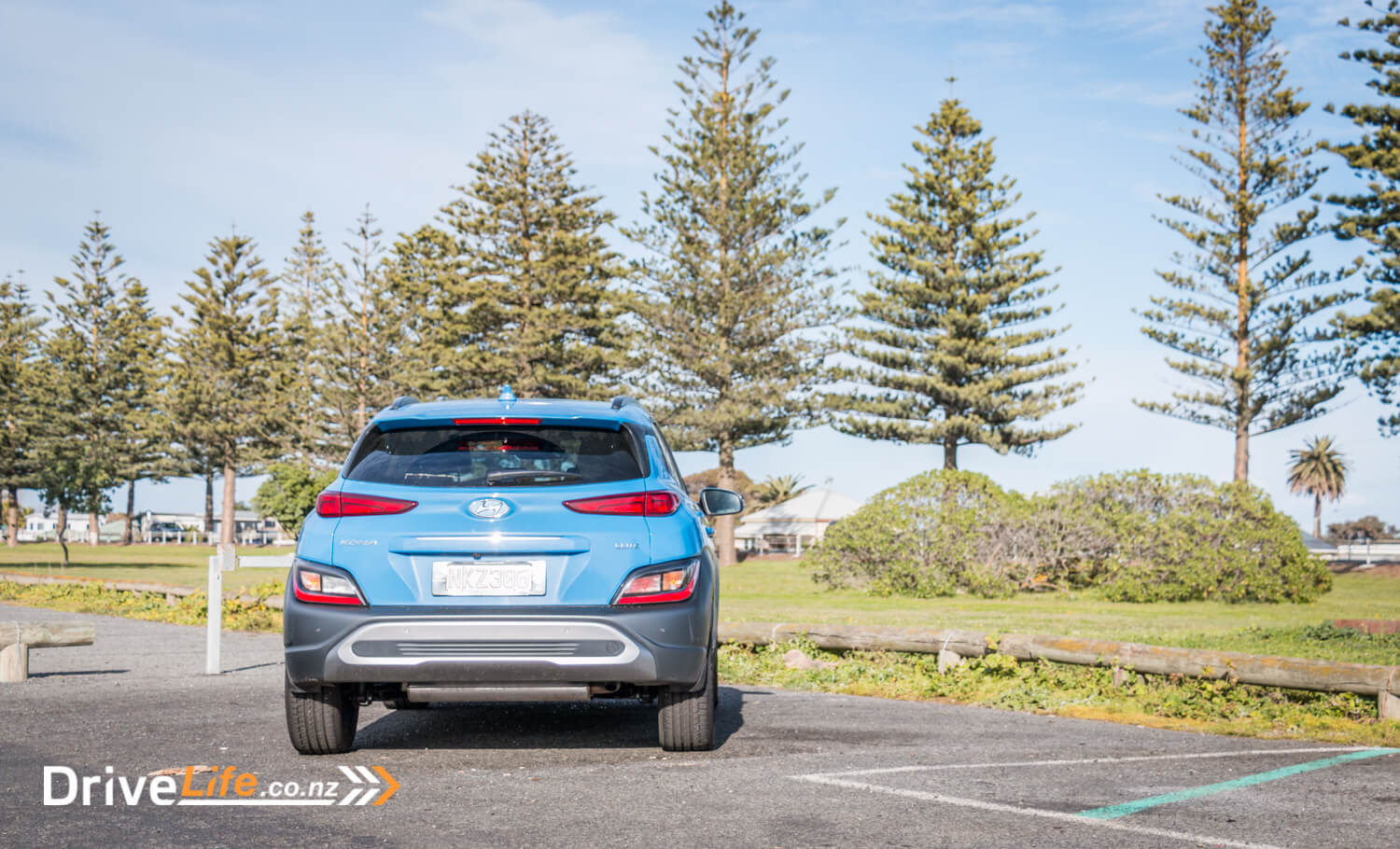
What Are The Pros and Cons Of The 2021 Hyundai Kona Elite?
| Pros Looks good Comfortable Great stereo Good to drive Smooth and quiet | Cons Over-sensitive safety functions Lane Assist inconsistent on New Zealand roads |

Specifications of the 2021 Hyundai Kona Elite
| Vehicle Type | Crossover SUV |
| Starting Price | $39,990 |
| Price as Tested | $39,990 |
| Engine | 2.0 litre 16 valve twin overhead cam with CVVT (Continuously Variable Valve Timing) |
| Power, Torque kW/Nm | 110/180 |
| Transmission | Intelligent Variable Transmission (IVT) |
| Spare Wheel | Space Saver |
| Kerb Weight, Kg | 1311 |
| Length x Width x Height, mm | 4205 x 1800 x 1565 |
| Cargo Capacity, litres Seats up/seats down | 374/1156 |
| Fuel capacity, L | 50 |
| Efficiency, L/100Km | Advertised Spec – combined – 6.9 Real World Test – combined – 6.2 |
| Towing Capacity Kg, unbraked/braked | 600/1300 |
| Turning circle, metres | 10.6 Small: 6-10m / Medium 10-12m / Large 12m+ |
| Warranty | 3 year / 100,000 km mechanical warranty 3 year / 100,000 km roadside assistance package |
| ANCAP Safety Ratings | 5 stars |



